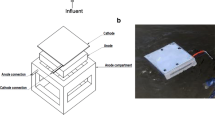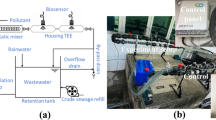Abstract
Real-time biomonitoring using microbial fuel cell (MFC) based biosensors have been demonstrated in several laboratory studies, but field validation is lacking. This study describes the long-term performance of an MFC based biosensor developed for real-time monitoring of changes in the water quality of a metal-contaminated stream. After a startup in the laboratory, biosensors were deployed in a stream close to an active mining complex in Sudbury, ON, Canada. Three sites within the stream were selected for biosensors installation based on their positions relative to the mining complex discharge points - upstream (lowest heavy metals concentration), midpoint and downstream. The biosensors installed at these sites were able to detect, in real-time, temporal changes in the water quality over a 2-month period. The biosensor response was confirmed by the results of a conventional toxicity assay (48-h acute Daphnia magna) as well as analytical measurements of heavy metals concentration in the stream. We conclude that the biosensor could detect changes in the overall water quality of the stream despite the uncontrolled situations typical for field operations as compared to laboratory conditions. To further explain the results observed during the field test, the rapid Microtox bioassay and D. magna assay were used to investigate the possible contributions of the two dominant mining metals (Nickel and Copper) to water toxicity in the test area.







Similar content being viewed by others
Data availability
Raw data is available on request.
References
Adekunle A, Raghavan V, Tartakovsky B (2017) Carbon source and energy harvesting optimization in solid anolyte microbial fuel cells. J Power Sources 356:324–330. https://doi.org/10.1016/j.jpowsour.2017.01.062
Adekunle A, Raghavan V, Tartakovsky B (2019) On-line monitoring of heavy metals-related toxicity with a microbial fuel cell biosensor. Biosens Bioelectron 132:382–390. https://doi.org/10.1016/j.bios.2019.03.011
Adekunle A, Rickwood C, Tartakovsky B (2020) Online monitoring of heavy metal–related toxicity using flow-through and floating microbial fuel cell biosensors. Environ Monit Assess 192:52
Al-Hejuje M (2012) A synergistic effect of copper and nickel ions on the growth rates of Pseudomonas aeroginosa and Staphylococcus aureus isolates. Basrah J Sci(B) 30:78–93
Babich H, Stotzky G (1982) Nickel toxicity to microbes: effect of pH and implications for acid rain. Environ Res 29:335–350
Babich H, Stotzky G (1983) Synergism between nickel and copper in their toxicity to microbes: mediation by pH. Ecotoxicol Environ Saf 7:576–587. https://doi.org/10.1016/0147-6513(83)90017-9
Beauchemin D (2010) Inductively coupled plasma mass spectrometry. Anal chem 82:4786–4810
Besley CHChessman BCJEI (2008) Rapid biological assessment charts the recovery of stream macroinvertebrate assemblages after sewage discharges cease 8:625–638
Brezonik P, King S, Mach CJIMEC, (1991) Applications. Advances in Trace Substances Research Series. The influence of water chemistry on trace metal bioavailability and toxicity to aquatic organisms. Lewis Publishers I, Chelsea, Michigan. p 1–31. 10 fig, 5 tab, 82 ref
Bulich AA (1986) Bioluminescence assays. Toxicity testing using microorganisms 1:57–74
Debabov VG (2008) Electricity from microorganisms. Microbiology 77:123–131. https://doi.org/10.1134/S002626170802001X
Environment Canada C (1992) Biological test method: toxicity test using luminescent bacteria (Photobacterium phosphoreum)
Erickson RJ, Benoit DA, Mattson VR, Leonard EN, Nelson HP (1996) The effects of water chemistry on the toxicity of copper to fathead minnows. Environ Toxicol Chemistry 15:181–193. https://doi.org/10.1002/etc.5620150217
Gunn J, Sarrazin-Delay C, Wesolek B, Stasko A, Szkokan-Emilson EJH, Assessment ER(2010) Delayed recovery of benthic macroinvertebrate communities in Junction Creek, Sudbury, Ontario, after the diversion of acid mine drainage 16:901–912
Herlory O, Bonzom J-M, Gilbin R, Frelon S, Fayolle S, Delmas F, Coste M (2013) Use of diatom assemblages as biomonitor of the impact of treated uranium mining effluent discharge on a stream: case study of the Ritord watershed (Center-West France). Ecotoxicology 22:1186–1199. https://doi.org/10.1007/s10646-013-1106-5
Houle J, Oman K, Gunn J (2007) Water Quality and Thermal Conditions in Upper Junction Creek and its Tributaries. Junction Creek Restoration Steering Committee. Unpublished
Huang J, Zhu N, Yang T, Zhang T, Wu P, Dang Z (2015) Nickel oxide and carbon nanotube composite (NiO/CNT) as a novel cathode non-precious metal catalyst in microbial fuel cells. Biosens Bioelectron 72:332–339
Hyne RV, Pablo F, Julli M, Markich SJJET, Journal CAI (2005) Influence of water chemistry on the acute toxicity of copper and zinc to the cladoceran. Ceriodaphnia cf dubia 24:1667–1675
Jadhav GS, Ghangrekar MM (2009) Performance of microbial fuel cell subjected to variation in pH, temperature, external load and substrate concentration. Bioresour Technol 100:717–723. https://doi.org/10.1016/j.biortech.2008.07.041
Jiang Y, Liang P, Huang X, Ren ZJ (2018) A novel microbial fuel cell sensor with a gas diffusion biocathode sensing element for water and air quality monitoring. Chemosphere 203:21–25. https://doi.org/10.1016/j.chemosphere.2018.03.169
Jiang Y, Liang P, Zhang C, Bian Y, Yang X, Huang X, Girguis PR (2015) Enhancing the response of microbial fuel cell based toxicity sensors to Cu(II) with the applying of flow-through electrodes and controlled anode potentials. Bioresour Technol 190:367–372. https://doi.org/10.1016/j.biortech.2015.04.127
Johnson M, Owen G (1966) Biological survey of the streams and lakes of the Sudbury area: 1965
Kim BH, Chang IS, Gadd G (2010) Microbial fuel cells as biochemical oxygen demand (BOD) and toxicity sensors. Bioelectrochemical systems. IWA Publishing, pp 347-367
McGregor R, Blowes D, Jambor J, Robertson WJEG (1998a) Mobilization and attenuation of heavy metals within a nickel mine tailings impoundment near Sudbury, Ontario. Canada 36:305–319
McGregor R, Blowes D, Jambor J, Robertson WJJoCH (1998b) The solid-phase controls on the mobility of heavy metals at the Copper Cliff tailings area, Sudbury, Ontario. Canada 33:247–271
Nriagu JO, Wong HK, Lawson G, Daniel PJSotTE (1998) Saturation of ecosystems with toxic metals in Sudbury basin, Ontario, Canada 223:99-117
Oh SE, Logan BE (2007) Voltage reversal during microbial fuel cell stack operation. J Power Sources 167:11–17. https://doi.org/10.1016/j.jpowsour.2007.02.016
Okamoto A, Yamamuro M, Tatarazako N (2014) Acute toxicity of 50 metals to Daphnia magna. J Appl Toxicol 35:824–830
Rodrigue A, Effantin G, Mandrand-Berthelot M-A (2005) Identification of rcnA (yohM), a Nickel and Cobalt Resistance Gene in Escherichia coli. J Bacteriol 187:2912–2916. https://doi.org/10.1128/jb.187.8.2912-2916.2005
Stein NE, Hamelers HMV, Van Straten G, Keesman KJ (2012) On-line detection of toxic components using a microbial fuel cell-based biosensor. J Process Control 22:1755–1761. https://doi.org/10.1016/j.jprocont.2012.07.009
Stein NE, Keesman KJ, Hamelers HVM, van Straten G (2011) Kinetic models for detection of toxicity in a microbial fuel cell based biosensor. Biosens Bioelectron 26:3115–3120. https://doi.org/10.1016/j.bios.2010.11.049
Stokes P, Szokalo AJWQRJ (1977) Sediment-water interchange of copper and nickel in experimental aquaria 12:157–178
Sun J-Z et al. (2015) Microbial fuel cell-based biosensors for environmental monitoring: a review 71:801–809
Weber LP, Dubé MG, Rickwood CJ, Driedger K, Portt C, Brereton C, Janz DM (2008) Effects of multiple effluents on resident fish from Junction Creek, Sudbury, Ontario. Ecotoxicol Environ Saf 70:433–445. https://doi.org/10.1016/j.ecoenv.2007.08.001
Yi Y, Xie B, Zhao T, Li Z, Stom D, Liu H (2019) Effect of external resistance on the sensitivity of microbial fuel cell biosensor for detection of different types of pollutants. Bioelectrochemistry 125:71–78. https://doi.org/10.1016/j.bioelechem.2018.09.003
Yu D, Bai L, Zhai J, Wang Y, Dong S (2017) Toxicity detection in water containing heavy metal ions with a self-powered microbial fuel cell-based biosensor. Talanta 168:210–216
Zhou T, Han H, Liu P, Xiong J, Tian F, Li X (2017) Microbial fuels cell-based biosensor for toxicity detection: a review. Sensors 17:2230
Zhu X, Logan BE (2014) Copper anode corrosion affects power generation in microbial fuel cells. J Chem Technol Biotechnol 89:471–474. https://doi.org/10.1002/jctb.4156
Acknowledgements
The Junction Creek Stewardship Committee’s help in collection of samples during the biosensor field deployment is greatly appreciated.
Author contributions
All the authors participated in research conceptualization, methodology, investigation, data curation and analysis and paper preparation.
Author information
Authors and Affiliations
Corresponding author
Ethics declarations
Conflict of interest
The authors declare no competing interests.
Additional information
Publisher’s note Springer Nature remains neutral with regard to jurisdictional claims in published maps and institutional affiliations.
Supplementary information
Rights and permissions
About this article
Cite this article
Adekunle, A., Rickwood, C. & Tartakovsky, B. On-line monitoring of water quality with a floating microbial fuel cell biosensor: field test results. Ecotoxicology 30, 851–862 (2021). https://doi.org/10.1007/s10646-021-02409-2
Accepted:
Published:
Issue Date:
DOI: https://doi.org/10.1007/s10646-021-02409-2




